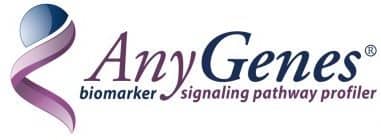
Logout
If you want to log out click in LogOut


AnyGenes was founded in 2007, by scientists with more than 20 years of experience in molecular and cellular biology. Our main focus is cell signaling pathways, epigenetic and RNA expression.
The company has developed a large portfolio of more than 500 cell signaling pathways ready-to-use in many species, at gene expression level. We expand this development to high quality reagents for the detection of mycoplasma in cell culture, the analysis of biomarkers in few cells, the expression analysis of LncRNA (long non-coding RNA), and specific assays for the analysis of microbiome…
As a complementary to our cell signaling pathways and products, we offer to our customers the opportunity to use our proprietary platform for customized services including drug development, biomarkers validation, mechanism of action analysis… AnyGenes scientists use and master cutting edge molecular technologies and working hard for the success of each project. We are proud of the constant high satisfaction of our customers
At AnyGenes, our goal is to provide scientists with the highest level of molecular services and easy-to-use kits. We believe that our innovative tools analyzing the dysfunction of RNA and signaling pathways in many diseases including cancer, contribute efficiently to the development of precision medicine.
For more information: www.anygenes.com
- Chen W et al. CircRNA circPTK2 Might Suppress Cancer Cell Invasion and Migration of Glioblastoma by Inhibiting miR-23a Maturation. Neuropsychiatr Dis Treat. (2021) 17: 2767-2774
- Reger de Moura C et al. CD147 Promotes Tumor Lymphangiogenesis in Melanoma via PROX-1. Cancers (2021) 13(19): 4859
- Linillos-Pradillo B et al. Determination of SARS-CoV-2 RNA in different particulate matter size fractions of outdoor air samples in Madrid during the lockdown. Environ Res (2021) 195:110863
- Garcia P et al. Disruption of NIPBL/Scc2 in Cornelia de Lange Syndrome provokes cohesin genome-wide redistribution with an impact in the transcriptome. Nature Communications (2021) 12(1): 4551
- Vasilopoulou F et al. Microarray Analysis Revealed Inflammatory Transcriptomic Changes after LSL60101 Treatment in 5XFAD Mice Model. Genes (2021) 12(9): 1315-1327
- Haijun Wan H et al. CircRNA CircRIMS is Overexpressed in Esophageal Squamous Cell Carcinoma and Downregulate miR-613 Through Methylation to Increase Cell Proliferation. Cancer Manag Res. (2021) 13: 4587-4595
- Ribó P et al. Mutation in KARS: A novel mechanism for severe anaphylaxis. J Allergy Clin Immunol. (2021) 147(5): 1855-1864
- Bouchet M et al. ERRα Expression in Bone Metastases Leads to an Exacerbated Antitumor Immune Response. Cancer Res. (2020) 80(13): 2914-2926
- Tétu P et al. FGF2 Induces Resistance to Nilotinib through MAPK Pathway Activation in KIT Mutated Melanoma. Cancers (2020) 12(5): 1062
- Moreno-Rubio J et al. Clinical-pathological and molecular characterization of long-term survivors with advanced non-small cell lung cancer. Cancer Biol Med. (2020) 17(2):444-457
- Tong C et al. Repurposing loperamide to overcome gefitinib resistance by triggering apoptosis independent of autophagy induction in KRAS mutant NSCLC cells. Cancer Treat Res Commun. (2020) 25: 100229
- Ataam AJ et al. Targeted Angiogenesis Gene Expression Profiling of Patients with Chronic Thromboembolic Pulmonary Hypertension. J. Heart Lung Transplant. (2020) 39(4): S31
- Martínez-García MA et al. TLR2 and TLR4 Surface and Gene Expression in White Blood Cells after Fasting and Oral Glucose, Lipid and Protein Challenges: Influence of Obesity and Sex Hormones. Biomolecules (2020) 10(1): 111
- Reger de Moura C et al. Intermittent Versus Continuous Dosing of MAPK Inhibitors in the Treatment of BRAF-Mutated Melanoma. Transl Oncol. (2019) 13(2): 275-286
- Louveau B et al. Baseline Genomic Features in BRAFV600-Mutated Metastatic Melanoma Patients Treated with BRAF Inhibitor + MEK Inhibitor in Routine Care. Cancers (2019) 11(8): E1203
- Dupain C et al. Newly identified LMO3-BORCS5 fusion oncogene in Ewing sarcoma at relapse is a driver of tumor progression. Oncogene (2019) 38(47): 7200-7215
- Reger de Moura C et al. Discoidin Domain Receptors: A promising target in melanoma. Pigment Cell Melanoma Res. (2019) 32(5): 697-707
- Louveau B et al. A targeted genomic alteration analysis predicts survival of melanoma patients under BRAF inhibitors. Oncotarget (2019) 10(18): 1669-1687
- Félix AJ et al. Functional pharmacogenomics and toxicity of PolyPurine Reverse Hoogsteen hairpins directed against survivin in human cells. Biochem Pharmacol. (2018) 155:8-20
- Torres RJ & Puig JG. Aicar effect in early neuronal development. Nucleos Nucleot Nucl. (2018) 37(5): 261-272
- Delyon J et al. STAT3 Mediates Nilotinib Response in KIT-Altered Melanoma: A Phase II Multicenter Trial of the French Skin Cancer Network. J Invest Dermatol. (2018) 138(1): 58-67
- Mgrditchian T et al. Targeting autophagy inhibits melanoma growth by enhancing NK cells infiltration in a CCL5-dependent manner. Proc Natl Acad Sci. (2017) 114(44): 9271-9279
- Buart S et al. Transcriptional response to hypoxic stress in melanoma and prognostic potential of GBE1 and BNIP3. Oncotarget (2017) 8(65): 108786-108801
- Broséus J et al. VEGF121, is predictor for survival in activated B-cell-like diffuse large B-cell lymphoma and is related to an immune response gene signature conserved in cancers. Oncotarget (2017) 8(53): 90808-90824
- Delyon J et al. PDE4D promotes FAK-mediated cell invasion in BRAF-mutated melanoma. Oncogene (2017) 36(23): 3252-3262
- Doucet M et al. Quality Matters: 2016 Annual Conference of the National Infrastructures for Biobanking. Biopreserv Biobank (2017) 15(3): 270-276
- Delyon J et al. Validation of a preclinical model for assessment of drug efficacy in melanoma. Oncotarget (2016) 7(11): 13069-13081
- Xu-Dubois YC et al. Markers of endothelial to mesenchymal transition: evidence for antibody-endothelium interaction during antibody mediated rejection in kidney recipients. J Am Soc Nephrol. (2016) 27(1): 324-332
- Mourah S et al. Dramatic Transient Improvement of Metastatic BRAFV600E-Mutated Langerhans Cell Sarcoma under treatment with Dabrafenib. Blood (2015) 126(24): 2649-2652
- Delyon J et al. EMMPRIN regulates β1 integrin-mediated adhesion through Kindlin-3 in human melanoma cells. Exp Dermatol. (2015) 24(6): 443-448
- Khayati F et al. EMMPRIN/CD147 is a novel coreceptor of VEGFR-2 mediating its activation by VEGF. Oncotarget (2015) 6(12): 9766-9780
- Ranchoux B et al. Endothelial-to-mesenchymal transition in pulmonary hypertension. Circulation (2015) 131(11): 1006-1018
- Djaafri I et al. A novel tumor suppressor function of Kindlin-3 in solid cancer. Oncotarget (2014) 5(19): 8970-8985
- Milia-Argeiti E et al. EMMPRIN/CD147-encriched membrane vesicles released from malignant human testicular germ cells increase MMP production through tumor-stroma interaction. Biochim Biophys Acta (2014) 1840(8): 2581-2588
- Lescaille G et al. EMMPRIN/CD147 up-regulates urokinase-type plasminogen activator: implications in oral tumor progression. BMC Cancer (2012) 12(115): 1-9
- Milia-Argeiti E et al. Imbalance of MMP-2 and MMP-9 expression versus TIMP-1 and TIMP-2 reflects increased invasiveness of human testicular germ cell tumours. Int J Androl. (2012) 35(6): 835-844
- Abdelkarim M et al. Invading Basement Membrane Matrix Is Sufficient for MDA-MB-231 Breast Cancer Cells to Develop a Stable In Vivo Metastatic Phenotype. PLoS ONE (2011) 6(8): e23334.
- Huet E et al. EMMPRIN Modulates Epithelial Barrier Function through a MMP-Mediated Occludin Cleavage: Implications in Dry Eye Disease. Am J Pathol. (2011) 179(3): 1278-1286
- Moreau M et al. b-Catenin and NF-κB cooperate to regulate the uPA/uPAR system in cancer cells. Int. J. Cancer (2011) 128(6): 1280-1292
- Bougatef F et al. EMMPRIN Promotes Melanoma Cells Malignant Properties through a HIF-2alpha Mediated Up-Regulation of VEGF-Receptor-2. PLoS One (2010) 5(8): e12265
- Paule B et al. Soluble Isoforms of Vascular Endothelial Growth Factor Are Predictors of Response to Sunitinib in Metastatic Renal Cell Carcinomas. PLoS One (2010) 5(5): e10715
- Ma L et al. Antisense Inhibition of Amphiregulin Expression Reduces EGFR Phosphorylation in Transformed Human Breast Epithelial Cells. Anticancer Res. (2010) 30(6): 2101-2106
- Bougatef F et al. EMMPRIN promotes angiogenesis through hypoxia-inducible factor-2-mediated regulation of soluble VEGF isoforms and their receptor VEGFR-2. Blood (2009) 114(27): 5547-5556
AnyGenes®
4 rue de la Chine
75020 Paris FRANCE
Phone: +33 (0) 1 43 58 88 63

